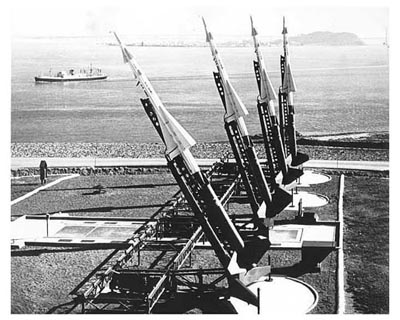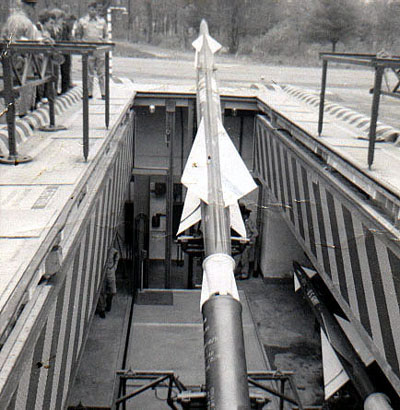THE CACHE HAS BEEN REPLACED WITH NEW COORDINATES. The buildings are GONE.
NO entrance after 4 p.m. as this is Foster Town land. Take Theodore Foster Rd. off Rt. 101 to access the site. I have permission for this geocache.
Origins Of The Nike System
http://www.themilitarystandard.com/missile/nike/pr-79_photos_3.php
Nike, named for the mythical Greek goddess of victory, was the name given to a program which ultimately produced the world's first successful, widely-deployed, guided surface-to-air missile system. Planning for Nike was begun during the last months of the Second World War when the U.S. Army realized that conventional anti-aircraft artillery would not be able to provide an adequate defense against the fast, high-flying and maneuverable jet aircraft which were being introduced into service, particularly by the Germans.

During 1945, Bell Telephone Laboratories produced the "AAGM (Anti Aircraft Guided Missile) Report" in which the concept of the Nike system were first outlined. The Report envisioned a two-stage, supersonic missile which could be guided to its target by means of ground-based radar and computer systems. This type of system is known as a "command" guidance system. The main advantage over conventional anti-aircraft artillery was that the Nike missile could be continuously guided to intercept an aircraft, in spite of any evasive actions taken by its pilot. By contrast, the projectiles fired by conventional anti-aircraft artillery (such as 90mm and 120mm guns) followed a predetermined, ballistic trajectory which could not be altered after firing.
The Nike Mission During the first decade of the Cold War, the Soviet Union began to develop a series of long-range bomber aircraft, capable of reaching targets within the continental United States. The potential threat posed by such aircraft became much more serious when, in 1949, the Russians exploded their first atomic bomb.
The perception that the Soviet Union might be capable of constructing a sizable fleet of long-range, nuclear-armed bomber aircraft capable of reaching the continental United States provided motivation to rapidly develop and deploy the Nike system to defend major U.S. population centers and other vital targets. The outbreak of hostilities in Korea, provided a further impetus to this deployment.
The mission of Nike within the continental U.S was to act as a "last ditch" line of air defense for selected areas. The Nike system would have been utilized in the event that the Air Force's long-range fighter-interceptor aircraft had failed to destroy any attacking bombers at a greater distance from their intended targets.
A Typical Nike Missile Site
A typical Nike air defense site consisted of two separate parcels of land. One area was known as the Integrated Fire Control (IFC) Area. This site contained the Nike system's ground-based radar and computer systems designed to detect and track hostile aircraft, and to guide the missiles to their targets.
The second parcel of land was known as the Launcher Area. At the launcher area, Nike missiles were stored horizontally within heavily constructed underground missile magazines. A large, missile elevator brought the Nikes to the surface of the site where they would be pushed (manually) by crewmen, across twin steel rails to one of four satellite launchers. The missile was then attached to its launcher and erected to a near-vertical position for firing. The near-vertical firing position ensured that the missile's booster rocket (lower stage) would not crash directly back onto the missile site, but, instead, would land within a predetermined booster impact area.
The control and launcher areas were separated by a distance of 1,000 to 6,000 yards (roughly 0.5- to 3.5-miles) and were often located within different townships. Technical limitations of the guidance system required the two facilities to be separated by a minimum of 3,000 feet. Whenever possible, control areas were constructed on high ground in order to gain superior radar coverage of the area. Control areas were generally located between the area being defended and the launcher area containing the missiles.
Nike Ajax: The First Nike Missile
The first successful test firing of a Nike missile occurred during 1951. This first Nike missile was later given the name Nike "Ajax". Nike Ajax was a slender, two-stage guided missile powered by a liquid-fueled motor utilizing a combination of inhibited red fuming nitric acid (IRFNA), unsymmetrical dimethyl hydrazine (UDMH) and JP-4 jet petroleum. The Ajax was blasted off of its launcher by means of a jettisonable solid fuel rocket booster which fired for about 3 seconds, accelerating the missile with a power of 25 times the force of gravity.

The Foster Nike Ajax Missile
The Ajax missile was capable of maximum speeds of over 1,600-mph and could reach targets at altitudes of up to 70,000 feet. Its range was only about 25 miles, which was too short to make it a truly effective air defense weapon in the eyes of its many detractors. Its supporters countered that the new missile was markedly superior to conventional antiaircraft artillery, and that it was, significantly, the only air defense missile actually deployed and operational at that time.
End Of The Nike Era
Although Nike was created in response to Soviet efforts to design and deploy long-range bomber aircraft during the early years of the Cold War, Soviet military strategy soon changed. By the late 1950s, fearing that their manned aircraft would be too vulnerable to attack by American interceptor aircraft armed with rockets and missiles, the Soviet Union focused more of its attention on developing ICBMs or Intercontinental Ballistic Missiles against which there existed, at that time, no effective defense. The Soviet long-range strategic bomber force continued to operate throughout the Cold War. However, these forces never achieved the size or capabilities of their American counterpart, the U.S. Air Force's Strategic Air Command or SAC.
The shifting nature of the Soviet threat meant that the air defense role, for which Nike was originally intended, became relatively less critical as time passed. Defense dollars were needed for other projects (including the development of American ICBMs and potential missile defenses) and also to fund the rapidly growing war in Vietnam. As a result, beginning in the mid 1960s, the total number of operational Nike bases within the continental U.S. was fairly steadily reduced, on an almost annual basis. All Nike Ajax sites in the continental United States were closed down by 1964. Closures of select Nike Hercules sites began during the mid 1960s.

Aerial view of the old Foster Nike Site.

Click To Rate This Cache